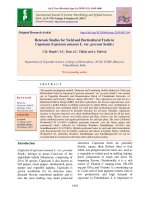Studies on effect of integrated weed management on growth, fruit and seed yield of dry chilli (Capsicum annuum L.) Var. LCA-334
Bạn đang xem bản rút gọn của tài liệu. Xem và tải ngay bản đầy đủ của tài liệu tại đây (211.79 KB, 6 trang )
Int.J.Curr.Microbiol.App.Sci (2019) 8(2): 2246-2251
International Journal of Current Microbiology and Applied Sciences
ISSN: 2319-7706 Volume 8 Number 02 (2019)
Journal homepage:
Original Research Article
/>
Studies on Effect of Integrated Weed Management on Growth, Fruit and
Seed Yield of Dry Chilli (Capsicum annuum L.) Var. LCA-334
M. Hanuman Nayak*, D. Anitha Kumari, A.V.N. Lavanya,
A. Mamatha and B. Lalu Naik
Vegetable Research Station, SKLTSHU, Rajendranagar, Hyderabad-500030, India
*Corresponding author
ABSTRACT
Keywords
Black Polythene
Mulch, Chilli,
Glyphosate,
Pendimethalin,
Straw Mulch,
Weed Management
Article Info
Accepted:
18 January 2019
Available Online:
10 February 2019
To study the effect of integrated weed management on growth and yield of chilli,
an experiment was laid out in randomized block design with nine different
treatments for weed management using weedicides, mulches (straw, black
polythene) and hand weeding at VRS, SKLTSHU, Rajendranagar, Hyderabad.
The data recorded for the different parameters showed significant variation among
the treatments. It was observed that dry fruit yield and seed yield per ha was
maximum in Weed free check- treatment T8 (53.18 q/ha and 15.95 q/ha
respectively) which was followed by treatment T7 - Hand weeding at 20,40 and 60
DAT recorded 41.15 q/ha of fruit yield and 12.34 q/ha of seed yield and minimum
was observed in treatment T9 (27.22 q/ha and 8.17 q /ha) i.e., week check (No
weeding-control) which is due to non-availability of water and nutrients to main
crop.
Introduction
Chilli (Capsicum annuum L.) is an important
commercial crop of India grown for its green
fruits as vegetable and riped dried form as
spice. In India dry chilli occupies an area of
809 thousands hectare with an annual
production of 2310 thousand MT (2017-18 3rd
advanced estimates). It is largely grown in
Andhra Pradesh, Telangana, Maharashtra,
Karnataka, Tamilnadu, Bihar, Rajasthan,
Punjab, Haryana and Madhya Pradesh. It is an
indispensable spice essentially used in every
Indian cuisine, due to its pungency, taste,
colour and aroma. Chilli fruits are rich
sources of vit C, A and E. Pungency of chilli
is due to crystalline volatile alkaloid called
capsaicin present in the placenta of fruit,
which has diverse prophylactic and
therapeutic uses in allopathic and ayurvedic
medicine. It is also a good source of
oleoresin, which has varied uses in processed
food and beverage industries. Because of this
there is a tremendous demand for Indian
chillies in the international market that
provides wide scope to increase export.
2246
Int.J.Curr.Microbiol.App.Sci (2019) 8(2): 2246-2251
Chilli is a long duration crop, usually infested
with a large number of broad-leaf and grassy
weeds, which emerge simultaneously, but
establish earlier than the crop. Practice of
adopting wide spacing, liberal supply of
organic manures, fertilizers and frequent
irrigations contribute to severe weed
infestation and their luxurious growth (Singh
et al., 1993).
Weeds emerge fast and grow rapidly
competing with the crop severally for growth
resources viz., nutrients, moisture, sunlight
and space during entire vegetative and early
reproductive stages of chilli. They also
transpire lot of valuable conserved moisture
and absorb large quantities of nutrients from
the soil. Further, wide space provided to the
chilli, allows fast growth of variety of weed
species causing a considerable reduction in
yield by affecting the growth and yield
components.
Weeds offer severe competition throughout
the crop growth. Owing to inherent
characteristics of chilli such as upright nature
of crop, wide spaced, slow initial growth and
less canopy, control of weeds is vitally
important not only to check the losses caused
by them but also to increase input use
efficiency. Thus, the extent of reduction in
fruit yield of chilli has been reported to be in
the range of 60 to 70 per cent depending on
the intensity and persistence of weed density
in standing crop (Sharma et al., 1988;
Narayana Rao, 1990).
To get effective control of complex weed
flora, integrated approach of weed
management is the best choice. In the present
investigation, an attempt was made to test the
feasibility of Pendimethalin, Glyphosate
herbicides alone and in combination with one
hand weeding, mulching with straw and black
polythene and hand weeding practices were
evaluated to develop an effective and viable
weed management practice for chilli.
Materials and Methods
The experiment was conducted during the
Rabi season of 2014-15, 2015-16 and 2016-17
at the Vegetable Research Station, Sri Konda
Laxman Telangana State Horticulture
University, Rajendranagar, Hyderabad. The
experiment was laid out in Randomized Block
Design with nine treatments and three
replications. The treatments comprises of
T1: Pre emergence application of
Pendimethalin @ 0.75 kg a.i. /ha,
T2: Pre emergence application of
Pendimethalin @ 0.75 kg a.i. /ha followed by
one hand weeding at 40DAT,
T3: Stale seed bed by glyphosate @1.00 kg
a.i. /ha at 15 days before
transplanting,
T4: Stale seed bed by glyphosate @1.00kg
a.i./ha at 15 days before transplanting
followed by one hand weeding at 40DAT,
T5: Mulching with black polythene,
T6: Straw mulch,
T7: Hand weeding at 20,40, and 60DAT,
T8: Weed free check (Irrespective of specific
intervals) and
T9: Weed check (No weeding, control) in plot
size of 4.2 X 3.5 m with an spacing
of 60 X 45 cm and the variety used is LCA334.
The observations were recorded for the
parameters such as plant height (cm), No. of
branches/plant, fruit length (cm), fruit girth
(cm), No. of fruits per plant, average weight
of 5 dry fruits, average yield of dry
fruits/plant (g), dry fruit yield (q/ha) and seed
yield (q/ha).
Results and Discussion
Analysis of variance of treatments revealed
that there is significant amount of variation
among the different weed control treatments.
2247
Int.J.Curr.Microbiol.App.Sci (2019) 8(2): 2246-2251
Growth parameters
Plant height (cm) was recorded highest for the
treatment T8 –weed free check (77.79 cm)
which was followed by T7 – hand weeding at
20, 40 and 60 DAT (77.19 cm) and minimum
plant height was recorded for the T9 -weed
check control (51.79 cm) (Table 1). No. of
branches/plant was maximum for the
treatment T8 –weed free check (9.34) and T7 –
hand weeding at 20, 40 and 60 DAT (9.04)
which were on par with each other followed
by treatment T5 i.e., Mulching with black
polythene (8.69) and minimum was recorded
for the treatment T9 -weed check control
(4.38) (Table 1). This may be due less
competition for nutrients and other available
resources in hand weeding plots resulted in
higher plant height and No. of branches/plant
of chilli when compared to the other
treatments. The above findings were in
conformity with Singh et al., (2009) and
Rahman et al., (2012) who also reported that
hand weeding is the most effective weed
control method in radish and garlic crops
respectively.
Fruit Parameters
Fruit length was recorded maximum for the
T8 treatment -weed free check (8.37 cm) and
T7 - hand weeding at 20, 40 and 60 DAT
(8.27) which are on par with each other which
was followed by T5 i.e., Mulching with black
polythene (8.00 cm) and minimum was
recorded for the T9 -weed check (7.21 cm)
(Table 1). Fruit girth was recorded maximum
for the treatment T8 i.e., weed free check
(4.32 cm) (Table 2) and T7 i.e., hand weeding
at 20, 40 and 60 DAT (4.21 cm) which are on
par with each other and followed by treatment
with black polythene mulch T5 (4.06 cm)
whereas the minimum fruit girth was recorded
for the control - treatment T9 (3.15 cm). No.
of fruits/plant was recorded maximum for the
treatment T8 i.e., weed free check (220.25)
(Table 2) which was followed by hand
weeding at 20, 40 and 60 DAT -T7 (208.87)
and minimum was recorded in control –no
weeding -T9 (168.77).
Yield parameters
Average dry weight of five fruits (g) was
recorded maximum for the weed free check treatment T8 (3.52 g) followed by hand
weeding at 20, 40 and 60 DAT- treatment T7
(3.02 g) whereas minimum was recorded
under weed check control for the treatment T9
(2.33 g) (Table 2). Dry fruit yield per plant
was recorded maximum for the treatment T8
(154.96 g) which was followed by T7 (114.23
g) and minimum was recorded for the weed
check treatment T9 (78.81 g) (Table 3).
Similarly, dry fruit yield per hectare was
recorded maximum for the treatment T8
(53.18 q/ha) which was followed by T7 (41.15
q/ha) and minimum was recorded for the
treatment T9 (27.22 q/ha). Presence of weeds
reduces the photosynthetic efficiency, dry
matter production and its distribution to
economical parts and there by reduces sink
capacity of crop resulting in poor fruit yield
(Table 3). Seed yield was found superior in
treatment T8 (15.95 q/ha) i.e., weed free check
which was followed by hand weeding
treatment T7 (12.34 q/ha) and minimum was
recorded for the treatment T9 (8.17 q/ha) i.e.,
weed check (Table 3).
In conclusion, hand weeding was the most
effective weed control method in enhancing
the growth and yield parameters of chilli. The
weed density, weed biomass were drastically
reduced as compared to weedy check.
Similarly, the number of fruits/plant, fruit
length and yield of chilli were also recorded
highest in weed free check followed by hand
weeding at 20, 40 and 60 DAT. Though hand
weeding is time consuming, expensive and
tedious, it was found to be much effective for
weed suppression.
2248
Int.J.Curr.Microbiol.App.Sci (2019) 8(2): 2246-2251
Table.1 Effect of integrated weed management on growth parameters of chilli at VRS, Rajendranagar, Hyderabad (2014-2017)
S. No
1
2
3
4
5
6
7
8
9
TREATMENTS
T1
T2
T3
T4
T5
T6
T7
T8
T9
CD @5%
CV %
2014-15
61.26
67.18
62.22
68.38
71.26
53.19
76.45
77.19
51.19
1.22
1.08
Plant Height (cm)
2015-16 2016-17
63.33
61.26
69.00
67.18
64.00
62.22
70.33
68.38
73.00
71.26
55.00
53.19
78.67
76.45
79.00
77.19
53.00
51.19
3.14
1.22
2.67
1.08
pooled
61.95
67.79
62.81
69.03
71.84
53.79
77.19
77.79
51.79
0.16
0.14
No. of branches / plant
2014-15 2015-16 2016-17 pooled
5.07
5.27
5.45
5.26
6.87
6.50
6.72
6.70
6.33
6.40
6.58
6.44
6.67
7.30
7.53
7.17
8.87
8.50
8.70
8.69
4.67
4.63
4.84
4.71
9.40
8.77
8.96
9.04
9.80
9.00
9.23
9.34
4.40
4.27
4.46
4.38
1.15
0.40
0.07
0.44
0.38
3.42
0.58
3.70
2014-15
7.64
7.84
7.87
7.93
8.03
7.38
8.39
8.44
7.23
N.S
0.47
Fruit length (cm)
2015-16 2016-17
7.27
7.46
7.33
7.54
7.20
7.51
7.67
7.95
7.87
8.10
7.10
7.45
8.10
8.33
8.20
8.47
7.10
7.30
0.38
0.22
2.93
1.59
pooled
7.46
7.57
7.53
7.85
8.00
7.31
8.27
8.37
7.21
0.17
1.30
Table.2 Effect of integrated weed management on yield parameters of chilli at VRS, Rajendranagar, Hyderabad (2014-2017)
S. No
1
2
3
4
5
6
7
8
9
TREATMENT
T1
T2
T3
T4
T5
T6
T7
T8
T9
CD @5%
CV %
2014-15
3.80
4.08
3.99
4.05
4.41
3.87
4.01
4.35
3.25
0.47
6.85
Fruit girth (cm)
2015-16 2016-17
3.60
3.88
3.83
3.97
3.67
3.84
3.97
4.14
3.80
3.97
3.53
3.72
4.20
4.42
4.17
4.43
3.00
3.21
0.32
0.11
5.02
1.57
pooled
3.76
3.96
3.83
4.05
4.06
3.71
4.21
4.32
3.15
0.23
3.36
No. of fruits/ plant
2014-15 2015-16 2016-17
191.74
181.14
185.64
179.89
187.91
181.68
167.58
176.47
172.67
187.64
189.25
183.36
194.26
201.25
199.31
187.67
194.74
186.00
204.34
208.64
213.64
224.64
219.64
216.47
170.64
166.52
169.14
3.17
3.35
4.46
1.01
1.01
1.36
2249
pooled
186.17
183.16
172.24
186.75
198.27
189.47
208.87
220.25
168.77
7.28
2.21
Average fruit weight/5 fruits
2014-15 2015-16 2016-17 pooled
2.60
2.25
2.50
2.45
2.30
2.65
2.45
2.47
2.20
2.45
2.55
2.40
2.75
2.45
2.65
2.62
3.00
2.70
2.90
2.87
2.55
2.95
2.7
2.73
3.05
3.15
2.85
3.02
3.65
3.40
3.50
3.52
2.40
2.10
2.50
2.33
0.78
0.81
0.56
0.31
5.36
6.31
6.25
6.62
Int.J.Curr.Microbiol.App.Sci (2019) 8(2): 2246-2251
Table.3 Effect of integrated weed management on yield parameters of chilli at VRS, Rajendranagar, Hyderabad (2014-2017)
S. No
1
2
3
4
5
6
7
8
9
TREATMENT
T1
T2
T3
T4
T5
T6
T7
T8
T9
CD @5%
CV %
Dry fruit yield per plant (kg)
201420152016- pooled
15
16
17
99.70
81.51
92.82
91.35
82.75
99.59
89.02
90.45
73.74
86.47
88.06
82.76
103.20
92.73
97.18
97.71
116.56 108.68 115.60 113.61
114.48 122.69 106.02 114.39
104.21 123.10 115.37 114.23
163.99 149.36 151.53 154.96
81.91
69.94
84.57
78.81
4.72
3.47
2.37
13.82
2.61
1.93
1.31
7.62
Dry Fruit yield (q/ha)
201420152016- pooled
15
16
17
28.53
32.49
31.97
31.00
34.86
31.16
31.66
32.56
30.26
30.82
28.96
30.02
32.46
34.01
34.20
33.56
38.04
40.46
39.76
39.42
42.94
37.11
40.04
40.03
43.08
40.38
39.98
41.15
52.27
53.04
54.23
53.18
24.48
29.60
27.58
27.22
2.07
2.34
2.36
3.32
3.29
3.69
3.75
5.26
2250
201415
8.56
10.46
9.08
9.74
11.41
12.88
12.93
15.68
7.34
1.26
6.65
Seed yield (q/ha)
2015- 2016- pooled
16
17
9.75 9.59
9.30
9.35 9.50
9.77
9.25 8.69
9.01
10.20 10.26 10.07
12.14 11.93 11.83
11.13 12.01 12.01
12.11 11.99 12.34
15.91 16.27 15.95
8.88 8.27
8.17
1.43 1.30
1.00
7.43 6.86
5.25
Int.J.Curr.Microbiol.App.Sci (2019) 8(2): 2246-2251
Less competition for nutrients and other
available resources in hand weeding plots
resulted in higher yield of chilli in these plots.
Similar results were found with Adhikary et
al., (2014) that, yield increase may be
attributed to more favorable soil moisture and
nutrient utilization. Next to hand weeding, the
treatment using black polythene mulch was
found effective as the plastic mulch prevents
the sunlight from reaching the soil inhibiting
the weed emergence. Weedy check recorded
significantly lowest pod yield/ha (27.63 q/ha).
These results are in agreement with Khan et
al., (2012) and Rajkumara (2009) on fruit
weight of chilli against different control
measures,
References
Adhikary P, Patra PS and Ghosh RK. 2014.
Efficacy of
plant
extracts
as
bioherbicide on weeds in soybean
ecosystem. Green Farming 5(3): 486488.
Khan A, Muhammad S, Hussain Z and
Khattak AM. 2012. Effect of different
weed control methods on weeds and
yield of chillies (Capsicum annuum L.).
Pakistan Journal of Weed Science
Research 18(1): 71-78.
Narayana Rao, K. 1990. Effect of herbicides
under different soil regimes on weed
control, yield and quality of chillies
(Capsicum annuum L.). In Abstract of
Papers
Presented
in
Biennial
Conference of Indian Society of Weed
Sciences, held at Jawaharlal Nehru
Krishi Vishwa Vidyalaya, Jabalpur, pp.
140·141.
Rahman UH, Khattak AM, Sadiq M, Ullah K,
Javeria S and Ullah I. 2012. Influence
of different weed management practices
on yield of garlic crop. Sarhad Journal
of Agriculture 28(2): 213-218.
Rajkumara S. 2009. Weed management in
onion-chilli cotton relay intercropping
in rainfed vertisols. Ph.D. Thesis,
University of Agricultural Science,
Dharwad.
Sharma, P.P., Lankroo, G.M. and Arya, P.S.
1988. Chemical weed control in bell
pepper
(Capsicum
annum
L.).
Vegetable Science 15: 113·119.
Singh, K., Pandita, M.L. and Thakral, K.K.
1993. Integrated weed management in
vegetable crops. In Proceedings of
International Symposium on Integrated
Weed Management for Sustainable
Agriculture, Vol. I, pp. 365·368. CCS
Haryana Agricultural University, Hisar.
Singh B, Bhullar MS, Walia US and
Randhawa SK. 2009. Effect of
herbicides on weed control yield,
quality and herbicide residue in radish.
Indian Journal of Weed Science
41(1&2): 46- 48.
How to cite this article:
Hanuman Nayak, M., D. Anitha Kumari, A.V.N. Lavanya, A. Mamatha and Lalu Naik, B.
2019. Studies on Effect of Integrated Weed Management on Growth, Fruit and Seed Yield of
Dry Chilli (Capsicum annuum L.) Var. LCA-334. Int.J.Curr.Microbiol.App.Sci. 8(02): 22462251. doi: />
2251
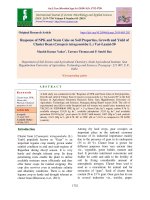
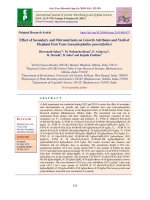
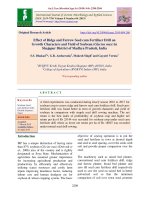
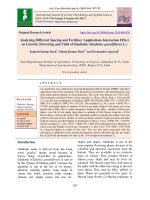

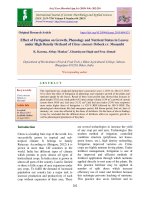

![Effect of precision farming techniques involving fertigation and mulching on growth attributes and seed yield of okra var. Arka Anamika [Abelmoschus esculentus (L.) Moench]](https://media.store123doc.com/images/document/2020_01/14/medium_ynr1578936108.jpg)

